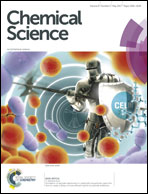Catalyst displacement assay: a supramolecular approach for the design of smart latent catalysts for pollutant monitoring and removal†
Abstract
Latent catalysts can be tuned to function smartly by assigning a sensing threshold using the displacement approach for targeted analytes. Three cyano-bridged bimetallic complexes were synthesized as “smart” latent catalysts through the supramolecular assembly of different metallic donors [FeII(CN)6]4−, [FeII(tBubpy)(CN)4]2−, and FeII(tBubpy)2(CN)2 with a metallic acceptor [CuII(dien)]2+. The investigation of both their thermodynamic and kinetic properties on binding with toxic pollutants provided insight into their smart off–on catalytic capabilities, enabling us to establish a threshold-controlled catalytic system for the degradation of pollutants such as cyanide and oxalate. With these smart latent catalysts, a new catalyst displacement assay (CDA) was demonstrated and applied in a real wastewater treatment process to degrade cyanide pollutants in both domestic (level I, untreated) and industrial wastewater samples collected in Hong Kong, China. The smart system was adjusted to be able to initiate the catalytic oxidation of cyanide at a threshold concentration of 20 μM (the World Health Organization’s suggested maximum allowable level for cyanide in wastewater) to the less harmful cyanate under ambient conditions.



 Please wait while we load your content...
Please wait while we load your content...